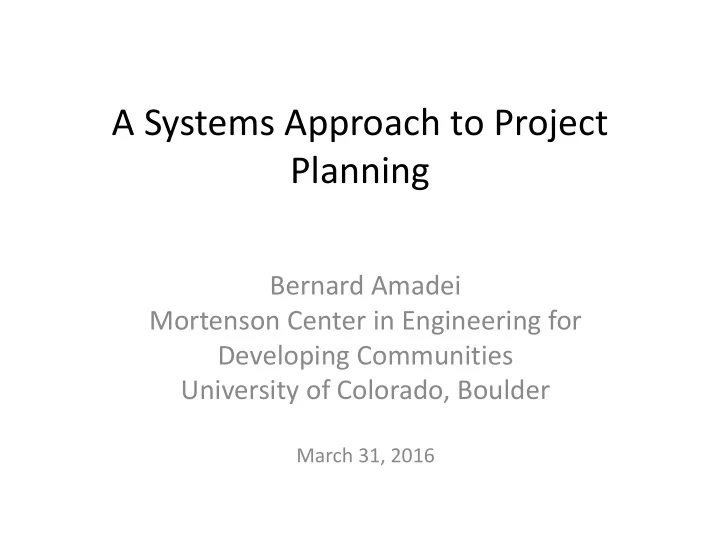

A Systems Approach to Project Planning Bernard Amadei Mortenson Center in Engineering for Developing Communities University of Colorado, Boulder March 31, 2016
How can Pakistan leverage its existing strength and capacity in STE to address the needs of the 67% (70%) who make less than $2 a day while at the same time continue to grow a global knowledge based economy?” (STE4D Conference, Islamabad, June 3, 2014).
Creating Healthy, Stable, Equitable, Safe, Prosperous Sustainable Communities
. After R. Waskom, N. Grigg, and M. Akhbari, 2014
What makes a system? • The parts or components • The relationship between the parts • The purpose of the system (subsystems may have several purposes conflicting or not) • Components operate under certain rules that control their behavior “ Nothing is completely itself without everything else” (T. Berry)
Types of Systems • Isolated: boundaries closed to import or export of both mass and energy • Closed: boundaries closed to import or export of mass, but not of energy • Open: exchange of both mass and energy with surroundings “When we try to pick up anything by itself, we find it is attached to everything in the universe” (John Muir)
Simple, Complicated, Complex • Simple: we know the knowns • Complicated: we know the unknowns • Complex: we don’t know the unknowns • Chaotic: it is all over the place The type of system dictates the methods of intervention
Communities as Complex Adaptive Systems • Constantly evolve and grow • Self‐organization, self‐correction, and adaptation by changing structure, behavior, rules of interaction through evolutionary and co‐ evolutionary change • Communities interact with their environment through feedback mechanisms
Communities as Complex Adaptive Systems • In order to address community issues and problems, complexity and uncertainty must be embraced and dealt with. • Ill‐defined problems, uncertainty, no unique and best solutions to complex problems exist, and satisficing (i.e., good enough) solutions.
Why Things Fail? Slowness of human thinking. We feel obliged to economize and simplify Slow speed in absorbing new material. We don ’ t think about problems we don ’ t have. Self protection. We need to have things easier and under control to preserve our expectation of success Limited understanding of systems: complexity, dynamics, mistaken hypotheses and ignorance
Water Energy Food/Ag Land Water used for Water used for Water contributes to energy extraction agricultural Water soil and aquifer and production, and production and replenishing bio (‐fuel) processing irrigation Energy used for Energy used to mechanized run water Energy for field agriculture in land Energy infrastructure, preparation and preparation, pumping, irrigation, harvest irrigation, and desalination fertilization, etc. Agriculture requires Production of water. Practices biofuels and biogas Agricultural practices must be respectful of Food/Ag uses food, need to be respectful run‐off, groundwater agricultural residues of land preservation recharge and biomass Soil type and Soil type affects the Soil type and vegetation affect soil Land energy consumption characteristics affect water saturation and for land use crop yield ground water
Weak Economy High Mortality Rate Water Quality Low Income from Overall Cash Crops Increased Sickness Pesticide/ Fertilizer Weak Farming Industry Poor Health Overuse Insufficient Low Productivity Cash Crops due to Malnutrition Less Farmers/Sellers Less Food Decrease Food Quality Low Crop Yields Pesticide/ Fertilizer Lack of Agriculture Knowledge Little water Poor Soil Quality Overuse Lack of Business Lack of Farming Poor Distribution Wet Season vs. Deforestation Knowledge Knowledge System Dry Season Lack of Knowledge of Soil No Training Damaged Irrigation Lack of access to Little Storage Nutrition & relationship Canals markets outside to crop yield the community ↓ Educa�on No Accountability Maintenance ↓ Supplies & Resources Lack of Education ↓ Funding Farmers Not willing to Lack of Organization Invest in Change Lack of Government Support Corruption
Strong Economy Decreased Mortality Rate Improved Water Increase Income Overall Quality from Cash Crops Decreased Sickness Decrease use of Strong Farming Industry Improved Health Pesticide/ Fertilizer Sufficient High productivity cash crops due to good More More Food Increase Food nutrition Farmers/Sellers Quality Increased Crop Yields Pesticide/ Increase Knowledge of Fertilizer Improved Soil Agriculture Increase in water improvement Quality Increase Business Increase Farming Improve Water storage Reforestation Knowledge Knowledge Distribution System during Dry Season Knowledge of Soil Repair/New Increase access to Training Increase Storage Nutrition & relationship Irrigation Canals markets outside Programs Capacity to crop yield the community Farmers are Accountability Available Supplies & Increase in Learned Educated among farmers Resources Education Maintenance techniques Increase Farmers Organized for Funding Co‐op program Farmers willing to Invest Lack of Government Support in Change
Multiple Criteria Decision Matrix
Social Network Analysis
Logical Decision Framework Outcomes Goals Objectives
System Science(s): Study of systems
System Dynamics “An approach to understanding the behaviour of complex systems over time. It deals with internal feedback loops and time delays that affect the behaviour of the entire system. What makes using system dynamics different from other approaches to studying complex systems is the use of feedback loops and stocks and flows. These elements help describe how even seemingly simple systems display baffling nonlinearity.” (Wikipedia, 2014) http://www.iseesystems.com
Linear Causality B A C Effect Cause Circular Causality A Feedback: shows how actions can reinforce (positive feedback) or counteract (balance through negative feedback) each other Variables are organized in a circle C B or loop of cause-effect relationship called a “feedback process”
Causal Loop Diagrams (CLDs)
Causal Loop Diagrams
Stock and Flow Diagrams
Modeling
Stock and Flow Diagrams
Framework
Project Identification Exit & Initiation Analysis of Appraisal Community Exit Appraisal Project Project Project Hypothesis Scaling Long-Term Benefits Reflection -in-Action Reflection Project Continuous -on-Action Strategy and Assessment Post Project Planning Reflection Refining Project the Work Exit Plan Strategy Project Execution
“The significant problems we face today cannot be solved at the same level of thinking we were at when we created them.” Albert Einstein Contact: amadei@colorado.edu
Recommend
More recommend